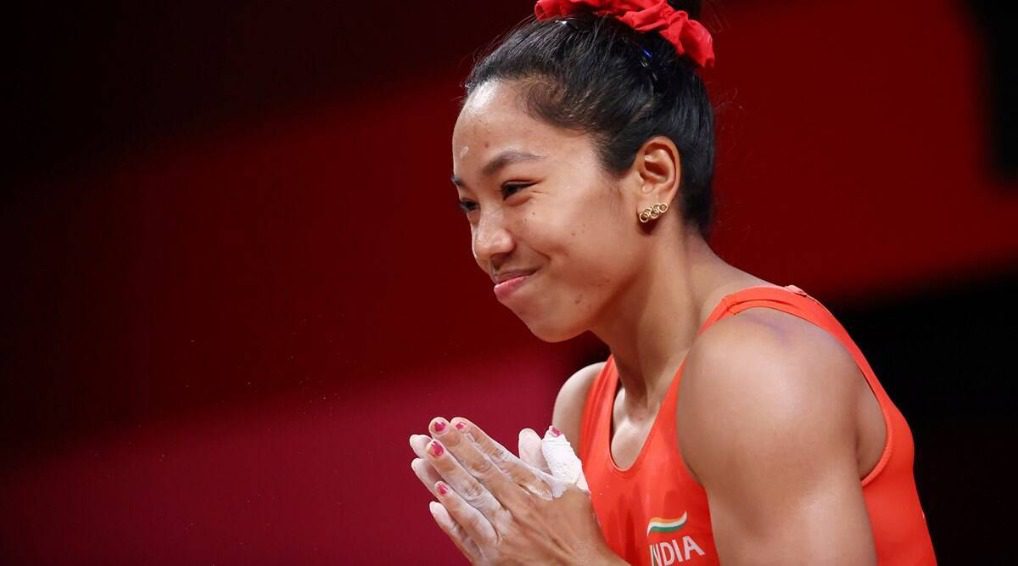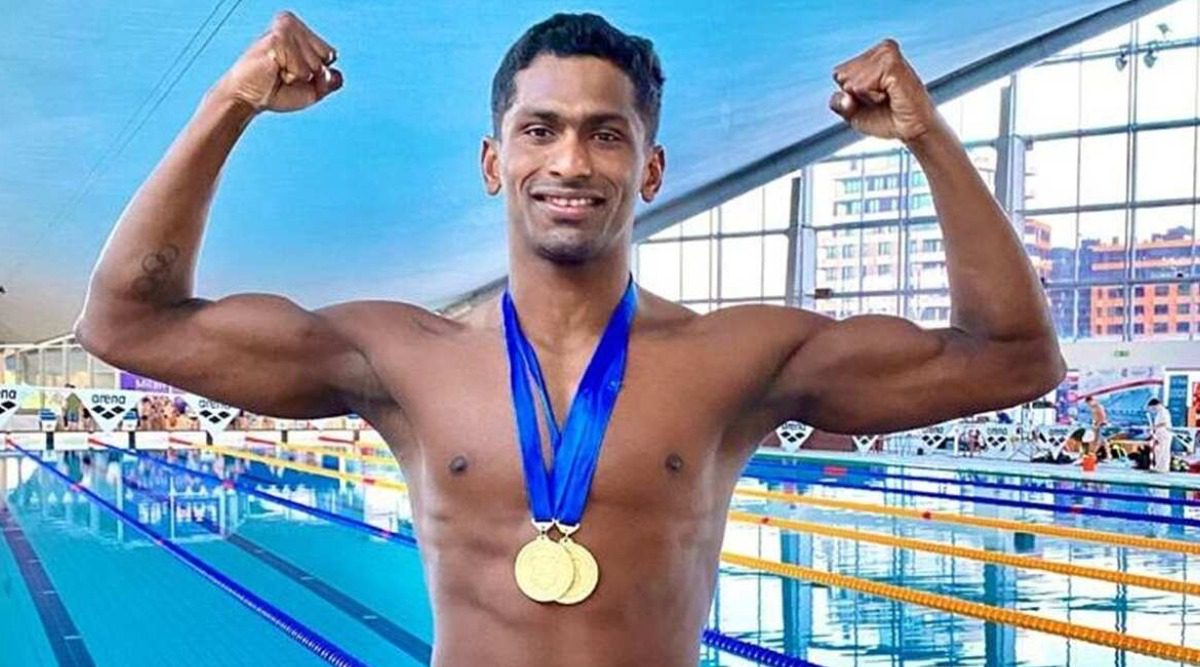(July 23, 9:05 am) Chanu Saikhom Mirabai‘s historic win at Tokyo Olympics 2020 is nothing short of a Bollywood film script. A girl from a small village in Manipur who picked firewood from the jungle as a teenager becomes the first Indian weightlifter to win an Olympic silver medal. But like every potboiler, this story isn’t without its share of twists and turns. It has the determination of an athlete, the struggles of a teenager, the support of family, the guidance of a coach, the thrill of competition, bouts of depression, the disappointment of failure, and the glory of a historic victory.
Chanu was just another medal contender at Olympics before the sporting spectacle kickstarted. But the 26-year-old weightlifter became a household name after clinching a silver by lifting a total of 202kg to give India its very first medal at Tokyo 2020.
Chanu’s victory on the very first day of the Olympics has energized India’s contingent.
But like many sportspersons, Chanu had her share of struggles before reaching the zenith of glory.
When supplies were limited
Born in an impoverished family in Manipur’s Nongpok Kakching, Chanu was the youngest among six siblings. With a meager monthly income of ₹4,000 to make ends meet, life wasn’t easy for the Saikhoms. As a 5-year-old, Chanu often carried buckets full of water on her head carefully balancing her way on the steep inclines while her brothers made their way to the nearby jungle to pick firewoods.
It was great to meet and congratulate the pride of India and honour of Indian Rly, @mirabai_chanu. Also felicitated her & announced Rs. 2 Cr , a promotion and more. She has inspired billions around the world with her talent, handwork and grit.
Keep winning for India! pic.twitter.com/gYRftarOrr— Ashwini Vaishnaw (@AshwiniVaishnaw) July 26, 2021
During one such trip, Mirabai Chanu accompanied her older brother into the hills. It was a typical day for the siblings but something was about to change for Chanu. The 12-year-old Chanu lifted a heavy stack of firewoods that her brother, who was four years elder to her, failed to do. This incident spread like wildfire in their village, and her strength to lift heavy woods became the talk of the town.
How Kunjarini Devi inspired Mirabai Chanu
This pushed her towards her dream of becoming a sportsperson. However, it was archery that Chanu had her eyes on. In the pursuit of fulfilling her dreams, she found herself at the gates of the Sports Authority of India center at Khuman Lampak Stadium in Imphal in 2008. But fate had other plans: She was unable to find any archery training session that day and instead chanced upon a few clips of popular Manipuri weightlifter Kunjarani Devi at the sports hall. Inspired by the seven-time silver medallist, Chanu found her calling in weightlifting.
View this post on Instagram
In a few days, she found herself under the tutelage of coach Anita Chanu. With no weightlifting infrastructure in her village, she traveled about 18 kilometers every day from home to the stadium, changing two buses or at times, taking a lift from a truck that passed through their village. A young Chanu toiled hard to maintain a balance between her studies and the love for weightlifting.
In a conversation with Indian Express, her mom Tombi Devi, opened up about Chanu’s struggles.
“Sometimes, she would travel on sand trucks or cycle to Imphal. There were days when she would have fare for only half the distance and would walk back home. Sometimes, her elder sisters would save money from their weaving and give her money for fare or other training expenses. The only thing which she did not lack was will power.”
Under the wings of her coach, Mirabai Chanu was unstoppable as she became the junior national champion in Chattisgarh in 2009, before making her debut in the national camp in 2011. She was determined to make India proud, someday, and she did exactly that in the 2014 Commonwealth Games. On the opening day of the competition, Chanu announced her arrival with a bang when she clinched a silver at the sporting spectacle.
The heartbreaking loss at Rio Olympics
With her stunning win at the Commonwealth Games, all eyes were on Chanu at the 2016 Rio Olympics. But the Padma Shri awardee failed to lift the weight in any of her three attempts in clean and jerk section. She froze. The heartbreaking defeat left the weightlifter depressed.
“My performance at the 2016 Rio Olympics was rather bad. I had failed in clean and jerk. I was really disappointed and depressed. My parents and my coach were there to motivate me throughout. But I realised that thinking too much about negatives, about what is not working, only increases the problem. I used to spend time with myself in the evenings, telling myself my future plans for which I needed to work harder. This method really helps me during any trouble, big or small,” she told HT Brunch.
But Chanu was determined to get back and march onward. After her Rio debacle, she silenced her detractors by winning gold in the 2017 World Championship. She did not stop there. The very next year, she became the first Indian athlete to bag gold at the 2018 Gold Coast Commonwealth Games.
View this post on Instagram
For the next two years, she was on a spree of breaking her own records. After lifting 210kg at the 2019 World Weighlifting Championship, the Rajiv Gandhi Khel Ratan Award winner took it a notch higher with a gold medal at National Weightlifting Championship in Kolkata in 2020.
Though the athlete was on a blitzkrieg, her back issue played a spoiler more than once. And that’s when coach Vijay Sharma took her to the US to train and recover under Dr. Aaron Horschig, an eminent physiotherapist. A few corrective exercises along with some tweaks helped Chanu secure bronze in the Asian Championships at Taskent in April 2021.
View this post on Instagram
The historic win at Tokyo Olympics
Filled with enthusiasm, Mirabai Chanu was ready to take on her biggest competitor Zhihui Hou from China at Tokyo Olympics. And sure she did. A day after boxer Mary Kom and Indian hockey team captain Manpreet Singh led the Indian contingent at the opening ceremony, Chanu showed her mettle at the biggest sporting spectacle.
Ending the 21-year-long wait in a few minutes, Chanu pocketed a silver in weightlifting in the 49kg category, thus becoming the first Indian weightlifter to win a silver medal at the Olympics and the first-ever Indian to win an Olympic medal on Day 1 of the Summer Games.
View this post on Instagram
The historic win not only opened India’s tally ay Olympics but also turned out to be a beacon of hope.
“I came here after years of hard work and when I stood on the podium, I forgot about the fatigue for some time as it’s like a dream come true,” she told WION after her historic win.
But it was her craving for pizza that melted many hearts. Being put on a strict diet for the competition, it was a pizza that Chanu dearly missed during her preparation. Encashing on the brand bandwagon, Dominos has offered lifetime free pizza to Chanu.
@Mirabai_chanu Congratulations on bringing the medal home! 🙌🏽🥈You brought the dreams of a billion+ Indians to life and we couldn’t be happier to treat you to FREE Domino’s pizza for life 🍕😊
Congratulations again!! #DominosPizza #PizzasForLife #Tokyo2020 #MirabaiChanu https://t.co/Gf5TLlYdBi— dominos_india (@dominos_india) July 24, 2021
She always maintained a strict diet regime. In a conversation with NDTV, Chanu said:
“I didn’t eat anything for two days before the competition because I was concerned about my weight.”
Two days after her epic win, the buzz has it that Chanu might be next in line to get her medal upgraded after gold medalist Zhihi Hou has been asked to take anti-doping tests. If Zhizhi Hou fails the test, Chanu will become the first Indian woman ever to win gold in weight lifting at Olympics.
Editor’s Take
History isn’t created every day. There are only a handful of people who bring pride to their nation, and weightlifter Mirabai Chanu is one of them. The Padma Shri awardee has many laurels to her credit, but it’s her epic win at the Tokyo Olympics that has made her a household name. With her grit and perseverance, the 26-year-old has put India on the world map. Her journey is a testament to the power of determination, perseverance, and relentless discipline. One hopes that her success inspires more Indians, especially from the Northeast, to take up weightlifting.
Find more fascinating Stories


